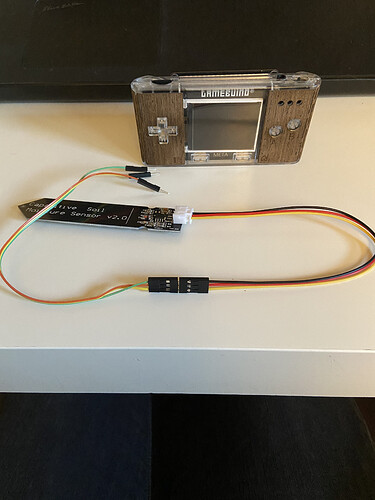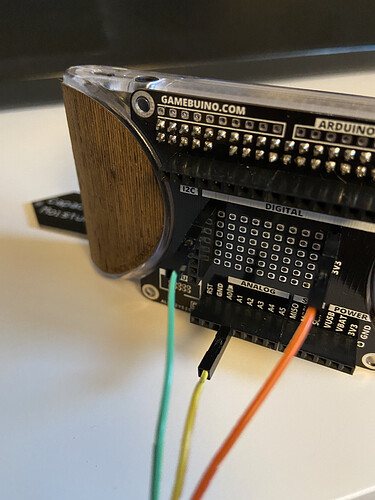You can find here the code I wrote to use a moisture sensor with the Gamebuino Meta. It provides a simple reading of the sensor feedback and displays a visual interpretation for easy use. Feel free to use this code for your own projects and discuss it.
/*Code by Tom from Gamebuino team
* version 1.0
* 22 of april 2021
*
* Intended as an example of hardware integration for Gamebuino Meta
*/
#include <Gamebuino-Meta.h>
//variable declaration for the sensor value and its conversion to percent
int32_t i32_moisture_value;
int32_t i32_moisture_percent;
//define of the analog pin used to plug the sensor, here it's A1
#define ANALOG A1
//define the delay between two alert sounds in miliseconds, here 5000 for 5 seconds
#define TICK_DELAY 5000
//declaration of the two variables needed to calculate time between two alerts
int32_t i32_last_tick;
int32_t i32_now_tick;
//this allows us to setup a basic timer functionnality
void setup() {
// put your setup code here, to run once:
gb.begin();
//initialization of the time variable to get a reference point (is close to 0 in this case)
i32_last_tick = millis();
}
void loop() {
// put your main code here, to run repeatedly:
while (!gb.update());
// the logic function will handle the math needed for the program
logic();
//the draw function will handle the display of all the elements needed for the program
draw();
}
void logic(){
// we read the value from the moisture sensor plugged to the analog port A1
// We need to substract this value from the max value of 1023 since the sensor output is inversely proportional to moisture detected
i32_moisture_value = 1023 - analogRead(ANALOG);
// we convert the value from a range of 0 to 1023 to a percentage
i32_moisture_percent = (i32_moisture_value * 100) / 1023;
//by storing the value returned by the milis() in one variable and comparing it to a reference we establish a timer system
//we then make the console emit a ticking sound at every TICK_DELAY interval if the moisture value is below a certain threshold, here 20%
i32_now_tick = millis();
if (i32_moisture_percent < 20 && i32_now_tick - i32_last_tick > TICK_DELAY){
gb.sound.playTick();
i32_last_tick = millis();
}
}
void draw(){
// the clear function is needed to reset the screen between each frame, otherwise frames would mix together and get messy
gb.display.clear();
// we print the value read from the moisture sensor and its value when converted to percentage
gb.display.print("sensor value = ");
gb.display.print(i32_moisture_value);
gb.display.print("\nmoisture \% = ");
gb.display.print(i32_moisture_percent);
//we draw a simple white rectangle to act as a gauge then fill it with another blue one whose lenght is tied to percentage
//note that we don't need to specifiy the white color for the forst rectangle since it is the default display color
gb.display.drawRect(5, gb.display.height()-15, gb.display.width()- 10, 10);
gb.display.setColor(BLUE);
gb.display.fillRect(6, gb.display.height()-14, (i32_moisture_value * (gb.display.width()- 12)) / 1023, 8);
}
Here are pictures showing how to the sensor is plugged on the console using the developper backpack expansion board for Gamebuino Meta :
The power and ground are connected to 3v3 and ground pins respectively while the sensor output is plugged into the analog pin A1.


